How to choose mountain sunglasses

*Article updated as of 23 November 2021.
Sunglasses are a fundamental part of our mountain equipment that sometimes we do not pay enough attention to. Sometimes we tend to see sunglasses as an accessory, as a decorative element, forgetting their main function.
Sunglasses are a Category I Personal Protective Equipment (PPE) that protects our eyes against ultraviolet rays and excess light, but also against the impact of insects, dust, rain, branches, wind, etc.
The danger of Ultraviolet Radiation.
Ultraviolet rays are part of the energy coming from the sun. They are composed of: UVA rays (long wave), UVB rays (medium wave) and UVC rays (short wave, totally absorbed by the ozone layer). Of the total UV radiation that reaches the earth's surface, 95% is UVA while 5% is UVB, the latter being more energetic and more harmful to health.
Eyes are extremely vulnerable to this type of radiation and without adequate protection, we can suffer from minor eye discomfort to serious diseases such as photokeratitis or snow ophthalmia, erythropsia, cataracts, macular disease and even cancer.
In the case of mountain sports, the danger is even greater. UV radiation is largely absorbed by the atmosphere, but the higher the altitude, the lower the layer that protects us. On average, it is estimated that every 1000 metres UV radiation increases by 10% to 12%, or even significantly more according to some studies in the Alpine region.
Altitude is not the only factor to take into account. UV radiation levels also depend on the position of the sun, latitude, cloud cover, the amount of ozone in the atmosphere they pass through and terrestrial reflection. In other words, the highest levels are recorded at midday, in summer (except in the tropics), on clear days, in certain tropical areas and on surfaces that reflect a lot of UV radiation (snow: 80% and seawater: 25%).
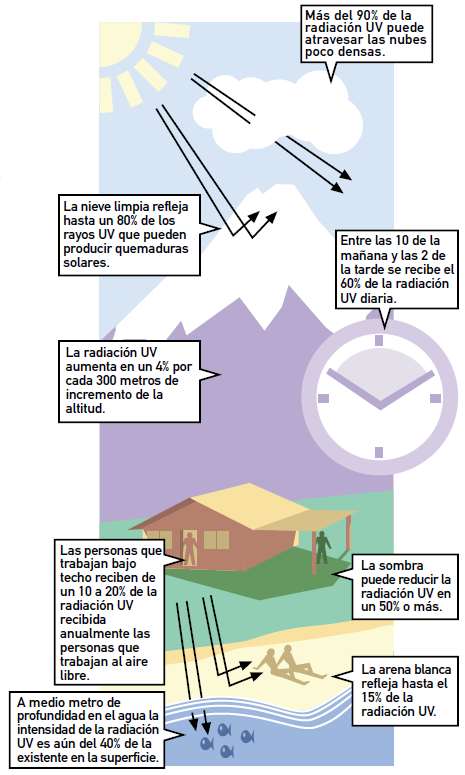
In the case of Spain, the AEMET publishes the maximum UV radiation index prediction for each day.
How to choose a pair of mountain sunglasses?
As we have already anticipated, the use of sunglasses is a matter of health and in the case of mountain sports, even more so. We will now go over the most important aspects to take into account when choosing a pair of mountain sunglasses, however, we did not want to leave the following point until the end. Our sunglasses must comply with the regulations and quality standards required by the European Union (or the American or Australian standards).
European EC type-approval standard.
Don't be taken for a ride. Sunglasses are best bought from opticians and specialised shops. In the case of the European Union, all sunglasses must be accompanied by the CE marking and the following information, which you will find somewhere on the temples:
- CE marking: European Union marking required for the distribution of sunglasses. It must be visible, legible and indelible. Not to be confused with China Exports.
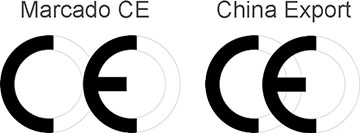
- Identification of the spectacle model.
- Manufacturer: name and address.
- Reference to ISO 12312
- Filter type: Photometric, polarised or gradient.
- Filter category.
- Information on the care and cleaning of spectacles.
- Restrictions on use (direct sun exposure, driving...).
UV protection
Our sunglasses, whether they are mountain sunglasses or everyday sunglasses, must have a filter that blocks between 99% and 100% UVA and UVB rays. The guarantee that this is the case can be found in sunglasses with the UV400 label.
Filter category
Not to be confused with the UV protection filter. When we talk about the filter category, we are referring to another type of radiation, the visible light spectrum and protection against brightness.
What is more, it happens that the darkest glasses are not always the ones that provide the best protection against solar radiation and the opposite effect can occur. Dark glasses will cause the pupil to dilate and if we do not have the right UV protection filter, we will be allowing more of this dangerous type of radiation into our eyes.
Sunglasses filters are classified into five levels of protection against visible light. Recommended for mountain activities are filters 3 (for most uses) and 4 (in high mountains, snow...), and to a lesser extent category 2.
| Filter Cat. | % Absorption | Weather | Uses |
|---|---|---|---|
| 0 | 0 – 20% | Very noble | Protect eyes from particles, insects, wind, etc. |
| 1 | 20 – 58% | Cloudy and clear | Urban use. Not recommended in bright light. |
| 2 | 59 – 82% | Average sunlight | Any mountain activity in medium light. |
| 3 | 82% – 91% | Strong sunlight | Any activity in the mountains with intense light and snow. |
| 4 | 91% – 98% | Extreme sunlight | Designed for high mountains. Very intense light and snow. |
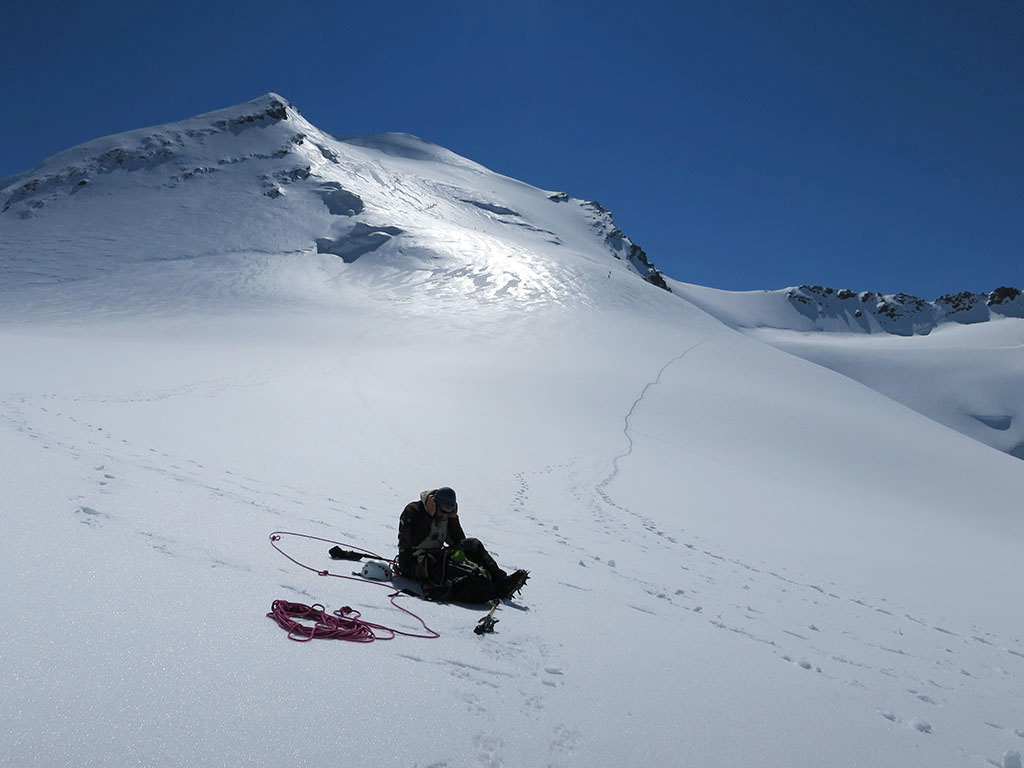
Lens colour
The colour of the lens alters the perception of colours and, depending on the intensity, reduces more or less the light reaching our eyes. Among the most common are the following:
- Grey: allows you to distinguish true colours uniformly. They reduce eye fatigue, so they are the most recommended for driving along with blue lenses. In the mountains they are one of the most commonly used.
- Yellow: For very cloudy or foggy days, yellow lenses are clearer and provide greater visibility and contrast.
- Brown: filter out blue radiation. They offer comfortable vision without altering colours too much. They reduce glare, improve contrast and increase depth of field. Excellent for variable weather conditions. Recommended for outdoor sports activities. Very suitable in snow.
- Green: they allow you to distinguish true colours uniformly. They are comfortable for outdoor activities and in various weather conditions. They have high glare protection. They have better contrast than grey lenses and better colour accuracy than brown lenses.
- Red-orange: these are the most commonly used in snow sports. They increase the contrast even more than the yellow ones.
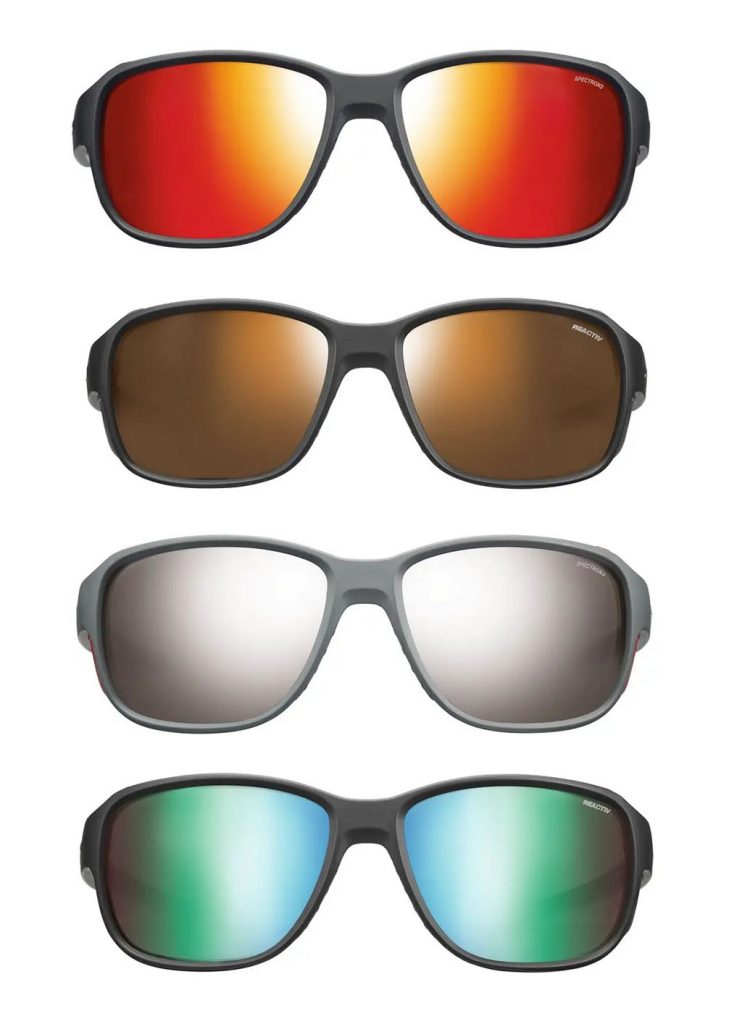
Photochromic lenses.
And what is this? Photochromic lenses are smart lenses that adapt to sunlight. Indoors and in low light conditions, the lenses appear almost transparent, but when the light conditions change, when you move to a brighter area, they automatically darken. It is true that the adaptation does not happen instantaneously, but the times are shorter and shorter, about 20 seconds.
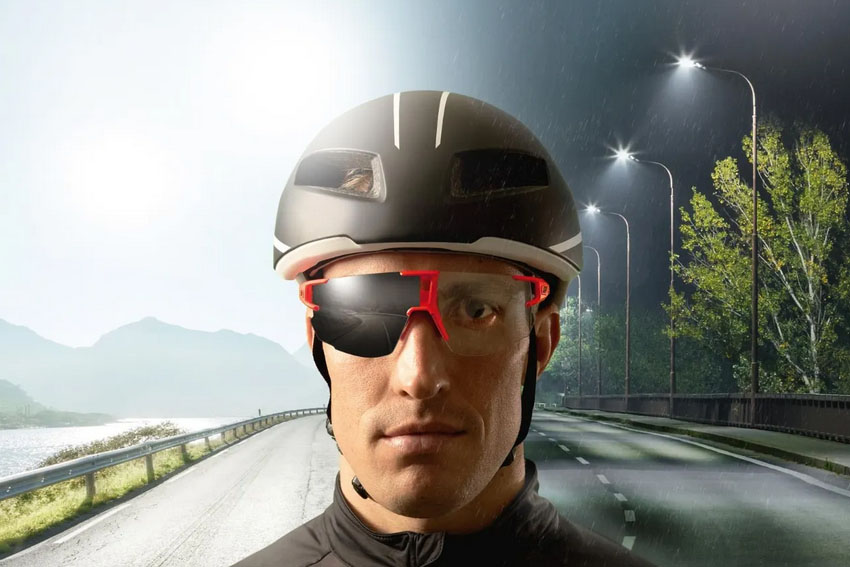
This is possible because the lenses contain copper or silver chloride, a substance that reacts to UV rays (now being discovered and replaced by faster changing polymers). This is why most glasses do not work for driving, as car windows prevent UV radiation from penetrating.
In the case of mountain goggles, photochromic lenses have become the most popular in the latest top-of-the-range models. The advantage is clear, their ability to adapt to changes in light. Going from a cloudy day to a sunny one, from a clear area to a wooded area...
The biggest drawback is the price.
Polarised lenses
When sunlight bounces off a horizontal surface, such as a lake or a road, it can sometimes cause reflected light that is very bright and annoying.
The polarised lenses contain a special filter that blocks this reflected light and lets only useful light through, allowing glare-free light with natural colour and contrast.
Lens material
Polycarbonate lenses are most common as they are relatively inexpensive and durable. Mineral glass lenses, with superior vision quality, are more scratch resistant, but more expensive and more fragile (risk of breakage).
Specific lens treatments:
In addition to all of the above, spectacle manufacturers add specific treatments to the lenses. In the case of Julbo's glasses with Reactiv Photochromatic lenses, the following treatments are added:
- Anti-fogging: prevents condensation and ensures maximum longevity.
- Anti-reflective: improves optical comfort and eliminates distracting reflections.
- Darkener: accentuates the filtering of visible light.
- Flash: reinforces the filtration of visible light by a mirror effect in the lens.
- Water-repellent: activates water slip, prevents hydrogen bonds between water molecules. Visibility is improved.
- Oleophobic treatment: prevents fingerprints, facilitates cleaning and facilitates the sliding of the water in the lentele.
Frame and design:
So far we have focused all the time on the lens, however, the frame and the design of the glasses play an important role in mountain glasses. Beyond the fact that we like the glasses aesthetically as they fit us, the main thing is to choose glasses that adapt perfectly to our face morphology. Some manufacturers have different models for men and women.
Goggles should protect us from wind, snow and cold. That's why mountain goggles usually have very enveloping designs or with (removable) side shields. Lately, the traditional goggles with round lenses and side shields made of leather or synthetic material have made a comeback, more as a fashion statement, such as the Julbo Cham.
Closed glasses or glasses that are too close to the face can cause fogging problems, which is why some designs incorporate ventilation systems or, as we saw earlier, anti-fogging treatments on the lenses.
It is advisable that the frame is curved, ergonomic, adapted to our physiognomy to ensure that the glasses are well secured and that we do not lose them. A cord is quite practical for this purpose. It is also advisable that the temples of the glasses, as well as the nose bridge, are made of a non-slip material.
Thin temples will fit better when wearing a helmet.
Prescription sunglasses
Although many (those who can) prefer to wear contact lenses instead of glasses for convenience, wearing contact lenses has the disadvantage of irritating the eyes due to sweat, sun cream or after many hours. In addition, cleaning and maintenance of contact lenses is more complicated when we go to the mountains for several days.
For those who have no choice but to wear prescription glasses, the most common option is unfortunately to pay twice. Buying a pair of mountain glasses to take advantage of the frame and replacing those lenses with prescription lenses in an optician's shop.
In some models it is possible to adjust the lenses directly or by means of an internal optical clip. In the case of the evil eyeIn its advertising, the brand promises that all its spectacle models can be prescription glasses and also offers, adapter and clip-in solutions.
Some models of mountain goggles
Julbo Explorer 2.0
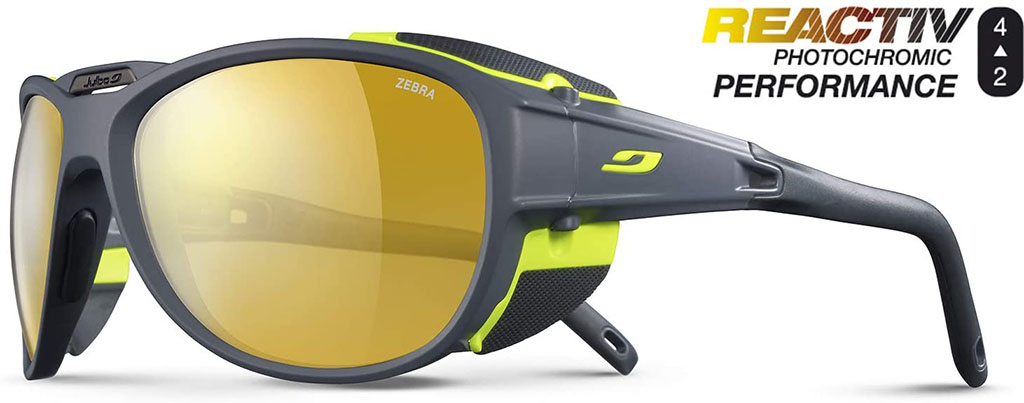
Julbo's top model. More ergonomic, more ventilated, slimmer and more elegant. The EXPLORER 2.0 reaches new heights of performance. Great coverage, removable shields, 360° adjustable temples, highly protective lenses, this glacier goggle is designed for extreme sport without compromise.
Julbo Shield
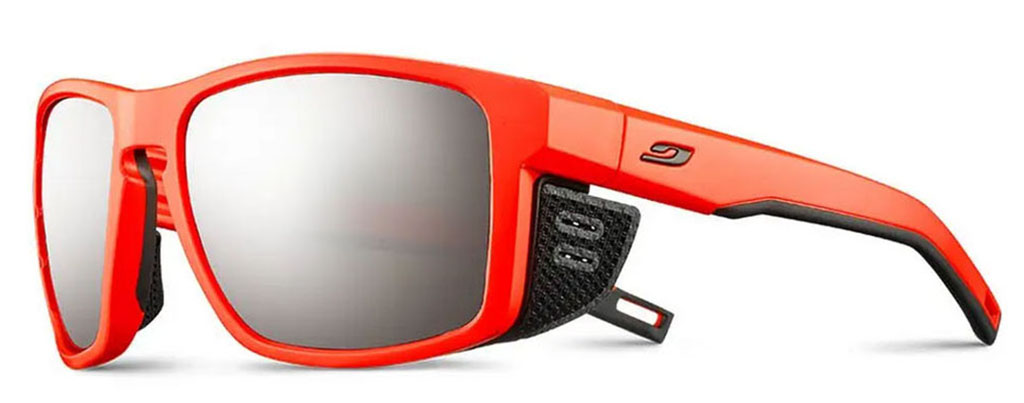
Julbo offers cross-mountain enthusiasts a stylish item to express its open-mindedness and technicality. The SHIELD, an all-terrain goggle with full protection, opens up the field of vision and the range of possibilities: Reactiv Photochromic lenses for perfect vision, curved non-slip temples with Grip Nose so that they stay on the head with every movement. Air Flow ventilation and soft touch removable "soft shield" protectors ensure maximum comfort. The sleek rectangular shape combines style with all kinds of boldness.
Julbo Camino

Julbo dedicates a stylish object to cross-mountain enthusiasts Julbo invents the essential, lightweight and functional tool for trekking enthusiasts. Ultra-clear, equipped with Reactiv Photochromic or category 4 protective lenses, CAMINO guarantees impeccable protection to go all the way.
Julbo Cham
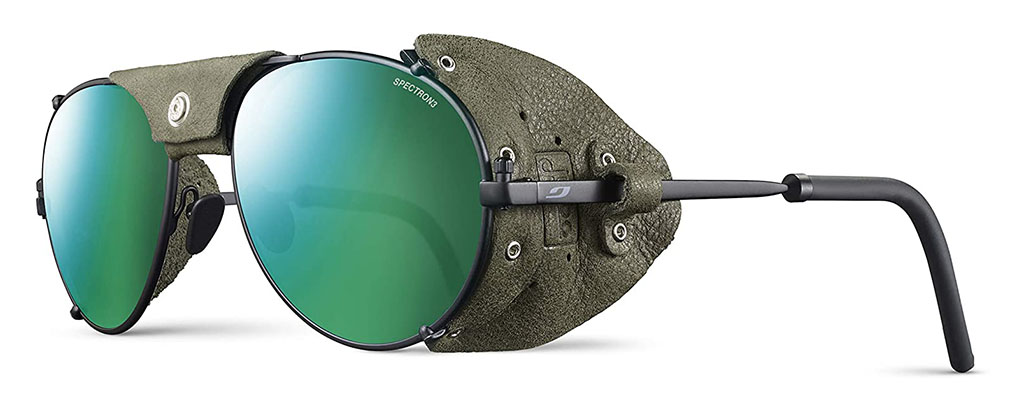
The legends of the summits are a tough nut to crack! The new generations miss the authentic frame with leather protectors, worn by the great Chamonix mountaineers all over the mountains of the world. With its reissue, Julbo offers much more than a goggle: pure emotion, an alchemy between shiny metal, supple leather, rivets... and high-performance mirrored lenses. A comfort and a vision of the mountains that is also expressed on the road or in the city.
Oakley Clifden
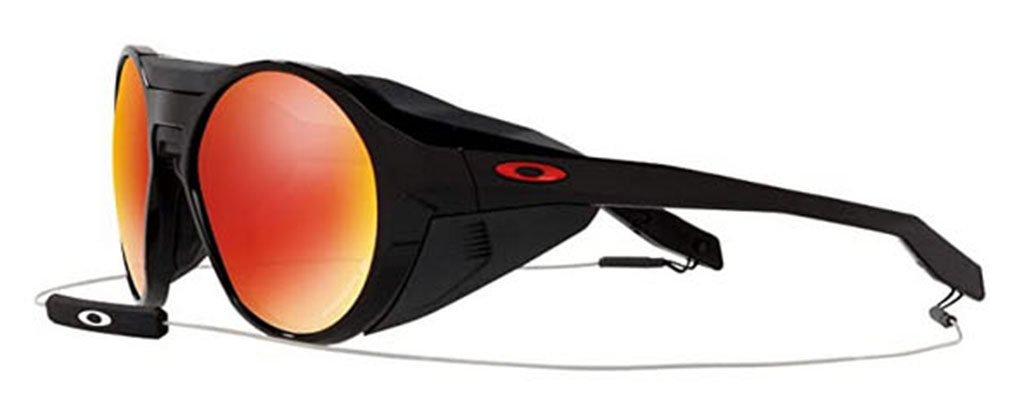
The ideal mountaineering goggle, designed to protect you from the elements. The style combines best-in-class Prizm™ lens technology with best-in-class frame design, side shields and a bridge blocker for added protection and an integrated strap for convenient storage and wearability.
Cébé Everest
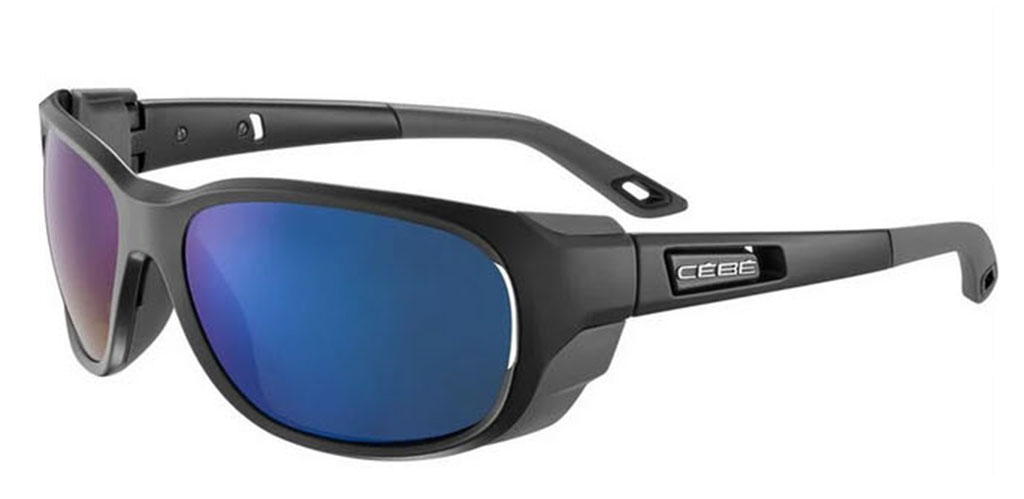
Step out of your comfort zone with Cébé's EVEREST mountaineering sunglasses. Category 2 to 4 photochromic or category 4 mineral lenses provide superior optical clarity, while the anti-reflective lens treatment protects your eyes from glare. Whether you're looking for mountain sunglasses for your next hike or hiking sunglasses, Cébé EVEREST will let you go further than ever before.
Bollé Graphite Red Matte
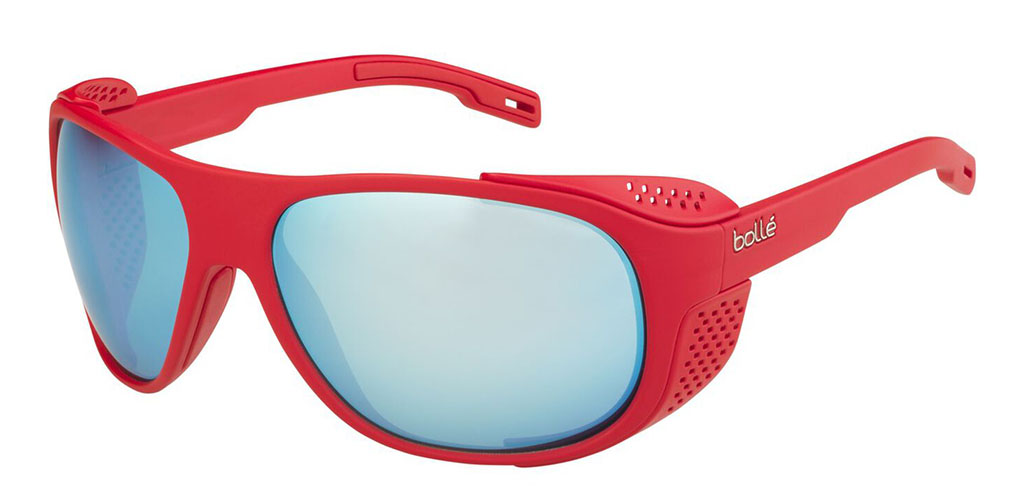
Bollé brings a new range to mountaineering. Go beyond your limits with GRAPHITE and reach new heights. Ergonomics, ventilation, protection, this glacier style has everything you need to withstand the most extreme experiences without any problem.
Fastpacking is not about going faster. It's about going lighter.
If you come from classic trekking, this is the next step: learning to move with less weight,
more fluid and enjoying every kilometre more.
Join the channel and start discovering what lightness feels like.
